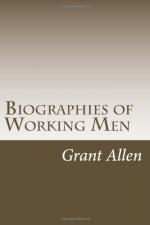The more the lad saw of clay and marble, the greater grew his distaste for mere woodwork. At last, he determined to ask Mr. Francis to buy out his indentures from the cabinet-makers, and let him finish his apprenticeship as a sculptor. But unfortunately the cabinet-makers found Gibson too useful a person to be got rid of so easily: they said he was the most industrious lad they had ever had; and so his very virtues seemed as it were to turn against him. Not so, really: Mr. Francis thought so well of the boy that he offered the masters 70 pounds to be quit of their bargain; and in the end, Gibson himself having made a very firm stand in the matter, he was released from his indentures and handed over finally to Mr. Francis and a sculptor’s life.
And now the eager boy was at last “truly happy.” He had to model all day long, and he worked away at it with a will. Shortly after he went to Mr. Francis’s yard, a visitor came upon business, a magnificent-looking old man, with snowy hair and Roman features. It was William Roscoe, the great Liverpool banker, himself a poor boy who had risen, and who had found time not only to build up for himself an enormous fortune, but also to become thoroughly well acquainted with literature and art by the way. Mr. Roscoe had written biographies of Lorenzo de Medici, the great Florentine, and of Leo X., the art-loving pope; and throughout his whole life he was always deeply interested in painting and sculpture and everything that related to them. He was a philanthropist, too, who had borne his part bravely in the great struggle for the abolition of the slave trade; and to befriend a struggling lad of genius like John Gibson was the very thing that was nearest and dearest to his benevolent heart. Mr. Francis showed Roscoe the boy’s drawings and models; and Roscoe’s appreciative eye saw in them at once the visible promise of great things to be. He had come to order a chimney-piece for his library at Allerton, where his important historical works were all composed; and he determined that the clever boy should have a chief hand in its production. A few days later he returned again with a valuable old Italian print. “I want you to make a bas-relief in baked clay,” he said to Gibson, “from this print for the centres of my mantelpiece.” Gibson was overjoyed. The print was taken from a fresco of Raphael’s in the Vatican at Rome, and Gibson’s work was to reproduce it in clay in low relief, as a sculpture picture. He did so entirely to his new patron’s satisfaction, and this his first serious work is now duly preserved in the Liverpool Institution which Mr. Roscoe had been mainly instrumental in founding.




